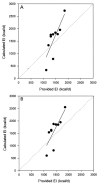Validation study of energy expenditure and intake during calorie restriction using doubly labeled water and changes in body composition
- PMID: 17209180
- PMCID: PMC2662402
- DOI: 10.1093/ajcn/85.1.73
Validation study of energy expenditure and intake during calorie restriction using doubly labeled water and changes in body composition
Abstract
Background: Clinical trials involving calorie restriction (CR) require an assessment of adherence to a prescribed CR with the use of an objective measure of energy intake (EI).
Objective: The objective was to validate the use of energy expenditure (EE) measured by doubly labeled water (DLW), in conjunction with precise measures of body composition, to calculate an individual's EI during 30% CR.
Design: Ten participants underwent 30% CR for 3 wk. During the last week (7 d), 24-h EE was measured in a respiratory chamber and simultaneously by DLW (EEDLW). EI was calculated from 7-d EE measured by DLW and from changes in energy stores (ES) (weight and body composition). Calculated EI was then compared with the actual EI measured in the chamber by using the following equations: calculated EI (kcal/d) = EEDLW + DeltaES, where DeltaESFM/FFM (kcal/d) = (9.3 x DeltaFM, g/d) + (1.1 x DeltaFFM, g/d), FM is fat mass, and FFM is fat-free mass.
Results: We found close agreement (R = 0.88) between EE measured in the metabolic chamber and EEDLW during CR. Using the measured respiratory quotient, we found that the mean (+/-SD) EE(DLW) was 1934 +/- 377 kcal/d and EE measured in the metabolic chamber was 1906 +/- 327 kcal/d, ie, a 1.3 +/- 8.9% overestimation. EI calculated from EEDLW and from changes in ES was 8.7 +/- 36.7% higher than the actual EI provided during the chamber stay (1596 +/- 656 kcal/d).
Conclusions: DLW methods can accurately estimate 24-h EE during CR. Although the mean difference between actual and calculated EIs for the group was small, we conclude that the interindividual variability was too large to provide an assessment of CR adherence on an individual basis.
Figures



Comment in
-
Validation of energy intake during calorie restriction with the doubly labeled water method and changes in body composition.Am J Clin Nutr. 2007 Oct;86(4):1251-2; author reply 1252-3. doi: 10.1093/ajcn/86.4.1251. Am J Clin Nutr. 2007. PMID: 17921412 No abstract available.
References
-
- Rothenberg E, Bossaeus I, Lernfeldt B, Landahl S, Steen B. Energy intake and expenditure: validation of a diet history by heart rate monitoring, activity diary, and doubly labeled water. Eur J Clin Nutr. 1998;52:832–8. - PubMed
-
- Seale JL, Rumpler WV. Comparison of energy expenditure measurements by diet records, energy intake balance, doubly labeled water, and room calorimetry. Eur J Clin Nutr. 1997;51:856–63. - PubMed
-
- Tomoyasu NJ, Toth MJ, Poehlman ET. Misreporting of total energy intake in older African Americans. Int J Obes Relat Metab Disord. 2000;24:20–6. - PubMed
-
- Ravussin E, Harper IT, Rising R, Bogardus C. Energy expenditure by doubly labeled water: validation in lean and obese participants. Am J Physiol. 1991;261:E402–9. - PubMed
-
- Schoeller DA, Webb P. Five-day comparison of the doubly labeled water method with respiratory gas exchange. Am J Clin Nutr. 1984;40:153–8. - PubMed
Publication types
MeSH terms
Substances
Grants and funding
LinkOut - more resources
Full Text Sources
Other Literature Sources
Medical

